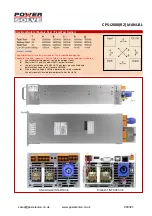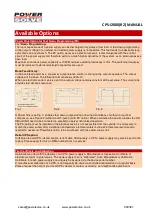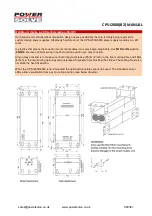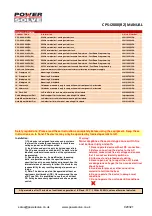
CPS-i2000(R2) MANUAL
Programming V/C via Potentiometer (Uadj/Iadj) – Stand Alone Operation
The power supply is equipped with 2 potentiometers Uadj and Iadj for setting voltage and current.
To enable the setting on the potentiometer, configure the interface via the DIP switch for 0-5V. Connect each
Uadj and Iadj of CON3 to the inputs Ureg-IN and Ireg-IN. If one of the two potentiometers is not used, the other
value can still be programmed via the interface. In such case, only the control signal 0-5V can be used.
Fuse Mode
The Fuse Mode can be used mode to prevent a major damage to a defective load. Fuse Mode can be activated
via the associated switch S12 DIP switch.
If the device is in the Fuse Mode (DIP switch S12=0), the device switches off when the constant current
operation is taking longer than typ. 5s. The red OCP LED flashes with a period of 0,4s. The PSU is locked. The
interlock can be canceled by the power supply is either switched off by the mains input, SB, or SD contact for a
moment.
Continuous Mode
If you select Continiuous Mode at DIP switch S12 (DIP switch S12=1), the device provides continuous power. It
also applicable in the Constant Current Mode. Factory setup = Continuous Mode
Over Load Behaviour
The CPS-i changes from the standard operation mode into the high current mode when high and fast overload
occurs. Thus, it provokes a restart after a 30ms break and delivers continuous current to the output. This
special behaviour is a protection for the power supply and for the connected load.
Compensation of Load Line Drop Voltage (Sense ++/--), standard operation mode
The CPS-i power supply has a Sense Mode to compensate for the voltage drop over long load lines. The
compensation amounts to a maximum of 2V per load line. Under certain circumstances, it can be expected to
apply more complicated external interference suppression. If sense is not used, CON4 Sense +/+ and Sense -/-
shall necessarily be connected by short bridges to the power outputs (factory setup).
Sense operation: Remove the bridges between Sense +/+, Sense -/- and the power outputs. Connect the sense
lines directly to the load. It is irrelevant which of the local connections Sense +/+ and Sense -/- are applied. Pay
attention to the polarity of plus and minus of the load to prevent damage to the power supply. To avoid
interference, twist the sense lines. To reduce inductive effects, we recommend that the load lines position is
close to each other. To supply a pulsating load, the use of an electrolytic capacitor and a cermic capacitor has
proved. The internal Over Voltage Protection (OVP) of the power supply controls the DC power directly to the
DC output terminals. In case of an error the OVP acts automatically (see OVP values corresponding table).
Operating in the sense mode requires that the maximum output voltage will not be exceeded. Maximum 2V per
load lead can be compensated. The voltage drop in the load lines decreases the maximum output voltage
rating. Example of a 30V unit: if the total voltage drop in the load leads is 2V it is necessry to subtract this value
from the maximum programmable output voltage 30V – 2V = 28V maximum available voltage at the load.
The sense terminals are directly connected to the power outputs.
Local Sensing
Remote Sensing
(factory setup)
(twisted sense lines)
WARNING! PROTECT TO MIX UP SENSE CONNECTIONS. THIS COULD CAUSE SERIOUS DAMAGE TO
THE DEVICE.
www.powersolve.co.uk
020321








































